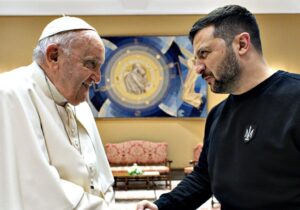As noted in Episode 3 of this series, by organizing into a unified frame what were then comparatively free-floating tenets, Thomas Aquinas helped articulate a clear moral vision for when it is right to fight. But while this now-recognizable jus ad bellum framework was a critical step toward laying the groundwork for a more systematized understanding of how one rightly fights the fight that’s right to fight, the heavy theoretical lifting that eventuated in the codification of an explicit jus in bello (jib) framework didn’t really begin until the rules for chivalric conduct in war came into view.
In limning the advent of a more-than-tacit jib, James Turner Johnson points to the era of the Hundred Years War, when influential writers drew together the ideas, customs, and practices from the knightly code of chivalry, Roman law—in particular the jus gentium—canon law, and the experiences of war and government. Following this, he asserts, the conception of a just war tradition now included both a jab and a jib. This conception of just war, then, was carried forward by late medieval and early modern just war thinkers to key figures such as the Dutch jurist Hugo Grotius, who employed just war tradition to ground his conception of the law of nations.
As we’ve already seen, in its Christian format the jib is popularly known to consist of two primary requirements: proportionality and discrimination—or noncombatant immunity. Recently, some Christian scholars—led by Eric Patterson—have sought to introduce—or, arguably, reinsert—the idea of military necessity into Christian just war jib frameworks. Historically, necessity has featured in legal textbooks and military doctrine and teaching. This isn’t to say that scholars outside legal and military frameworks ignore the concept of necessity. Instead, in those circles, necessity typically is understood as a challenge—or exception—to the restraints of proportionality and discrimination. A classic example of this would be Michael Walzer’s notion of “extreme emergency” in which he insists that if something like an existential threat to the political community is looming, then the traditional restraints can be ignored. In a similar way, the sometimes patron-saint of this journal, Reinhold Niebuhr—though not, I argue a just war scholar—understood necessity to allow for the gloves to come off.
In contrast to this, in the hands of lawyers and warfighters, necessity was more often a means of fortifying restraint. This notion grounds Military Necessity and Just War Statecraft, a book I recently co-edited with Patterson. The subtitle offers the BLUF: The Principle of National Security Stewardship. The argument is a truism: if it’s not necessary, don’t do it. Wars are always costly in blood and treasure. At the jib level, if a particular mission or tactical scenario is not necessary for moving toward victory, then it probably ought not to be done. This shouldn’t be overstated. It’s unlikely that any given action is, itself, absolutely essential to victory. But wars, naturally, can’t be won if they aren’t fought and fighting requires particular kinds of actions that, together, build toward victory: leaving the wire to search for the enemy leads to contact, successful contact can lead to firefights, successful firefights can aggregate to successful battles, successful battles to successful campaigns, and successful campaigns to the overall victory.
It may be that a given action—a particular search and destroy mission—is low on the necessity spectrum. On such occasions, if other values, such as force protection or noncombatant immunity, are sufficiently at risk then prudence might dictate standing down. Other missions might be deemed so high up on the necessity scale that even significant losses to force or risks to noncombatants is deemed worthwhile. In this way, we can see how necessity as restraint and necessity as spur can be reconciled. Necessity can work both directions at once. But precisely how we understand it to work this way is crucial.
There is a tension in war that is sometimes framed as the dialectic between military objectives and humanitarian or moral principles. While it’s obviously true—even a truism—that an illegitimate military objective is rightly in tension with moral concerns, the tension isn’t resolved simply by pursuing an objective that is legitimate. For it may be that a proper objective can be pursued through unjustified means, as some insist is the case regarding, say, the link between the bombing of Hiroshima and Japanese surrender. Yet, the tension is still not necessarily resolved even if we have both a legitimate military objective and a justified means of pursuing it. One reason for this is because there is a lot riding on what the term “justified” means. Some—Niebuhr for example—argue that simply because context and limited options might mean particular kinds of horrible actions are temporarily justified, this still doesn’t make them morally right. One must simply live with the moral tension of overruling moral rules if the ends are critical enough. This is insufficient.
The just war framework asserts that humanitarian and military necessity are not polar opposites. Instead, military necessity and moral concern can–even must–live side-by-side without contradiction. The tradition goes further to suggest that military necessity can, in particular circumstances, help shape the moral analysis of a conflict situation. What it doesn’t endorse is the proposal that military necessity can simply abrogate moral norms. Even as we promote military necessity from a tacit to an articulated element of just war statecraft it’s essential to require that the doctrine of necessity distance itself from the logic of Walzer’s supreme emergency. Military necessity serves, not sidelines, the just war framework in its function to help direct the moral use of proportionate and discriminate force, including in hard cases, to appropriately intended aims.
It is in this way that necessity will prove itself to be both a restraint as well as a spur to action. This is a remedial boon. Not only does it rectify the tendency of too many thinkers who view the just war framework writ large as simply a leash on force, but it realigns the jib with the jab, which has always had both. Proper authority, just cause, and right intent can be properly viewed as the deontological elements of the framework, alerting the moral analyst that action is permitted or perhaps even required. The prudential elements—last resort, proportionality, and probability of success serve as restraints. Now the jib, too, through necessity, has the spur. Meanwhile, proportionality and discrimination primarily serve as side-constraints.
There will be times, therefore, when military necessity will equal moral imperative.







 Sponsor a student for Christianity & National Security 2024
Sponsor a student for Christianity & National Security 2024